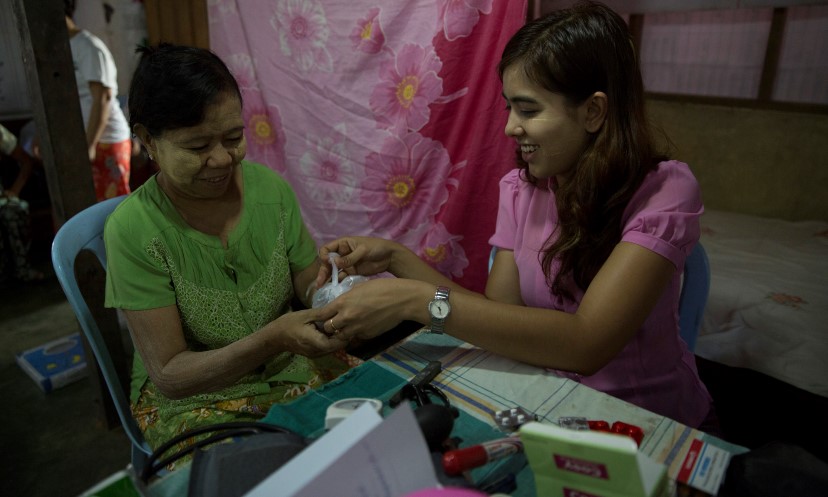Diabetes and older people
Prevalence
Nine percent of adults globally have diabetes, which is one of the four leading NCDs across the world.[1,2]
Type 2 diabetes makes up 90% of cases worldwide, but can be managed inexpensively with early diagnosis and treatment.[3]
Diabetes-related deaths are predicted to rise by over 50 per cent in the next 10 years.[4]
More than 80 per cent of diabetes-related deaths occur in low and middle income countries.[5]
Diabetes and older people
Levels of diagonsed and undiagonsed type 2 diabetes increase with age, leading to a significantly higher prevalence in older people. In China, for example, diabetes prevelance in the over-70 age group is almost double that in those aged 50-59.[6,7]
Global data sets do not routinely record data for older people or disaggregate data by age. Lack of data contributes to low levels of awareness of diabetes in older people, by policy makers, service providers and older people themselves.[8]
This leads to a lack of services targeted at people in older age and older people not seeking treatment until their condition is well advanced. For example, when surveyed, 15 per cent of people with type 2 diabetes in South Africa[9] and 20 per cent in India[10] had not received treatment in the previous year. Lack of treatment increases the risk of complications, such as heart attacks, kidney failure, blindness and amputations.[11]
Older people with diabetes are also more likely to have other conditions, particularly cardiovascular disease, stroke and hypertension. Data from Ghana, for example, has shown that 80 per cent of older people with diabetes also had hypertension.[12]
Screening, diagnosis, treatment and care
The main modifiable risk factors for type 2 diabetes are excess weight and lack of physical exercise. Non-modifiable risk factors include family history, ethnicity and age. Access to information about risk factors can help to prevent or delay diabetes.
Receiving an early diagnosis is important to enable people to manage their diabetes before chronic health problems develop. For this reason, screening of older people is widely recommended.[13] This can be done inexpensively through blood testing in primary healthcare settings.[14]
People with type 2 diabetes can usually be treated effectively with oral medication. This can be delivered at relatively low cost at the primary healthcare level.[15] Type 2 diabetes and its associated complications can also be managed through monitoring blood pressure and cholesterol levels, providing foot care, and screening for sight problems and kidney disease. Maintaining a healthy diet, undertaking regular exercise and avoiding smoking are also important factors in controlling diabetes.
- WHO, Global status report on noncommunicable diseases, 2014.
- WHO, 2014.
- WHO, Definition, diagonises and classification of diatbetes mellitus and its complications, 1999.
- WHO, 10 facts about Diabetes, 2014.
- WHO, Global Health Estimates: Deaths by Cause, Age, Sex and Country, 2000-2012, 2014.
- International Diabetes Federation (IDF), Global Guideline for Managing Older People with Type 2 Diabetes 2013; Yang W et al., 'Prevalence of diabetes among men and women in China', New England Jounral of Medicine, 362:1090-1101, March 25, 2010.
- WHO, SAGE, 2016 Naidoo N.
- WHO Global Monitoring Framework on NCDs measures NCD mortality between 30 and 70; WHO STEPwise approach to Surveillance (STEPS) data collection stops at 64; IDF Atlas collates data up to age 79 but does not disaggregate by age. However studies have shown that levels are increasing, consistent with demographics on ageing. Eg Werfalli M et al, ‘The prevalence of type 2 diabetes among older people in Africa: a systematic review’, Lancet, 4(1): 72-84, Jan 2016.
- South Africa Study on Global Ageing and Adult Health (SAGE), Wave 1, Phaswana-Mafuya N et al, WHO, 2012.
- India: SAGE, Wave 1, Arokiasamy P et al, WHO, 2013.
- WHO, Diabetes Factsheet No 312, updated January 2015.
- Ghana: SAGE Wave 1, Biritwum R et al, WHO, 2013.
- IDF, 2013.
- WHO, Package of Essential Noncommunicable (PEN) Disease Interventions for Primary Health Care in Low-Resource Settings, 2010.
- WHO, 2010.

